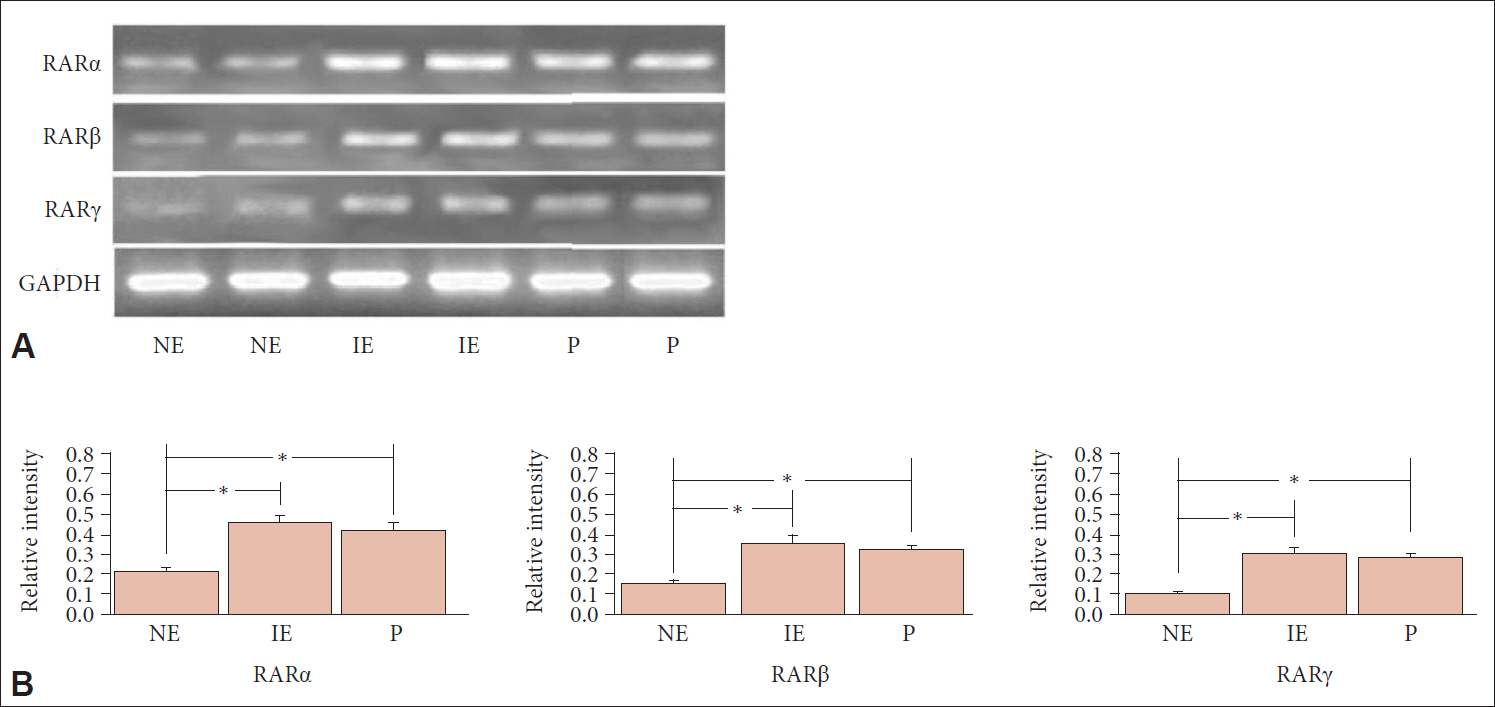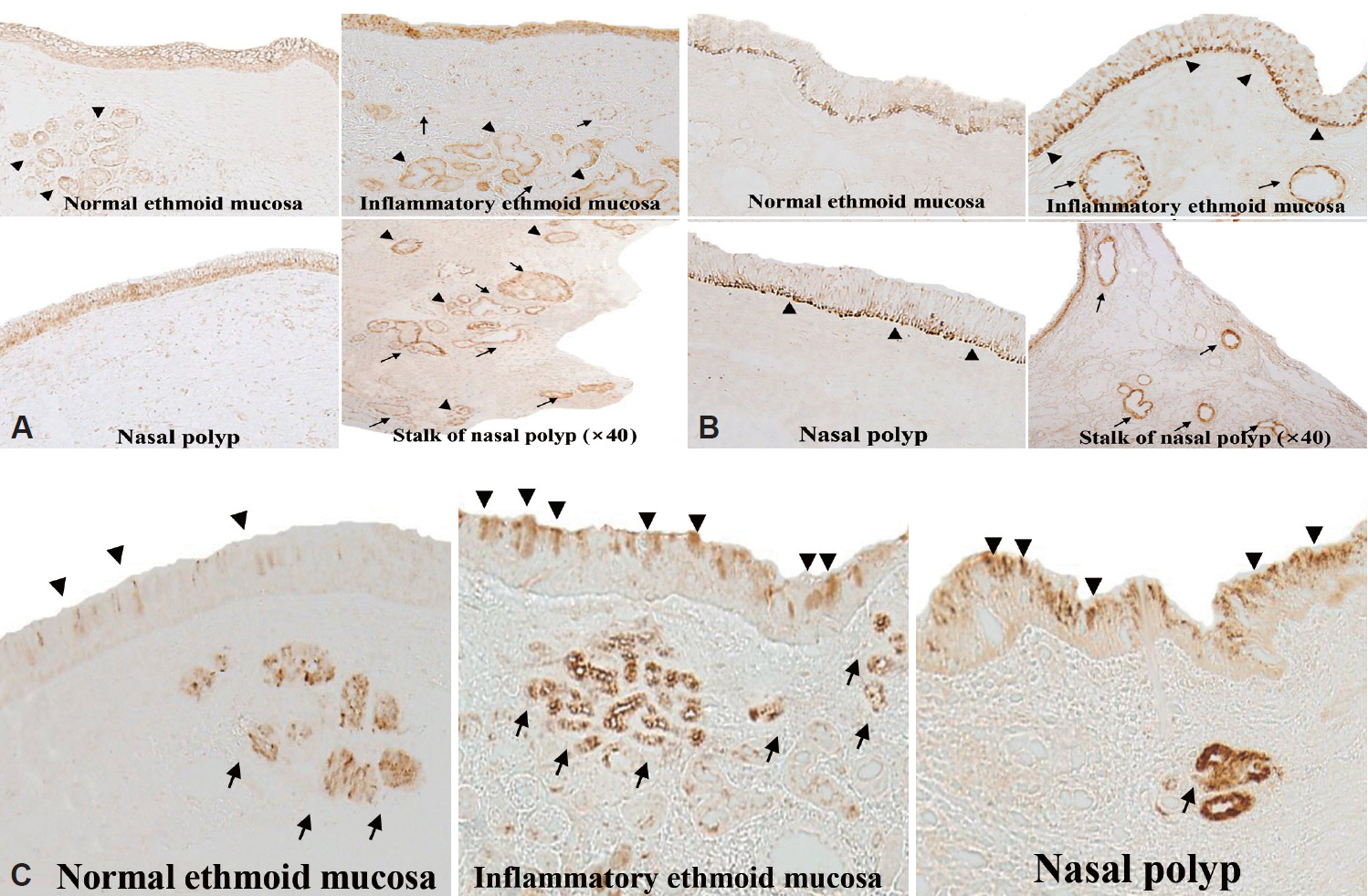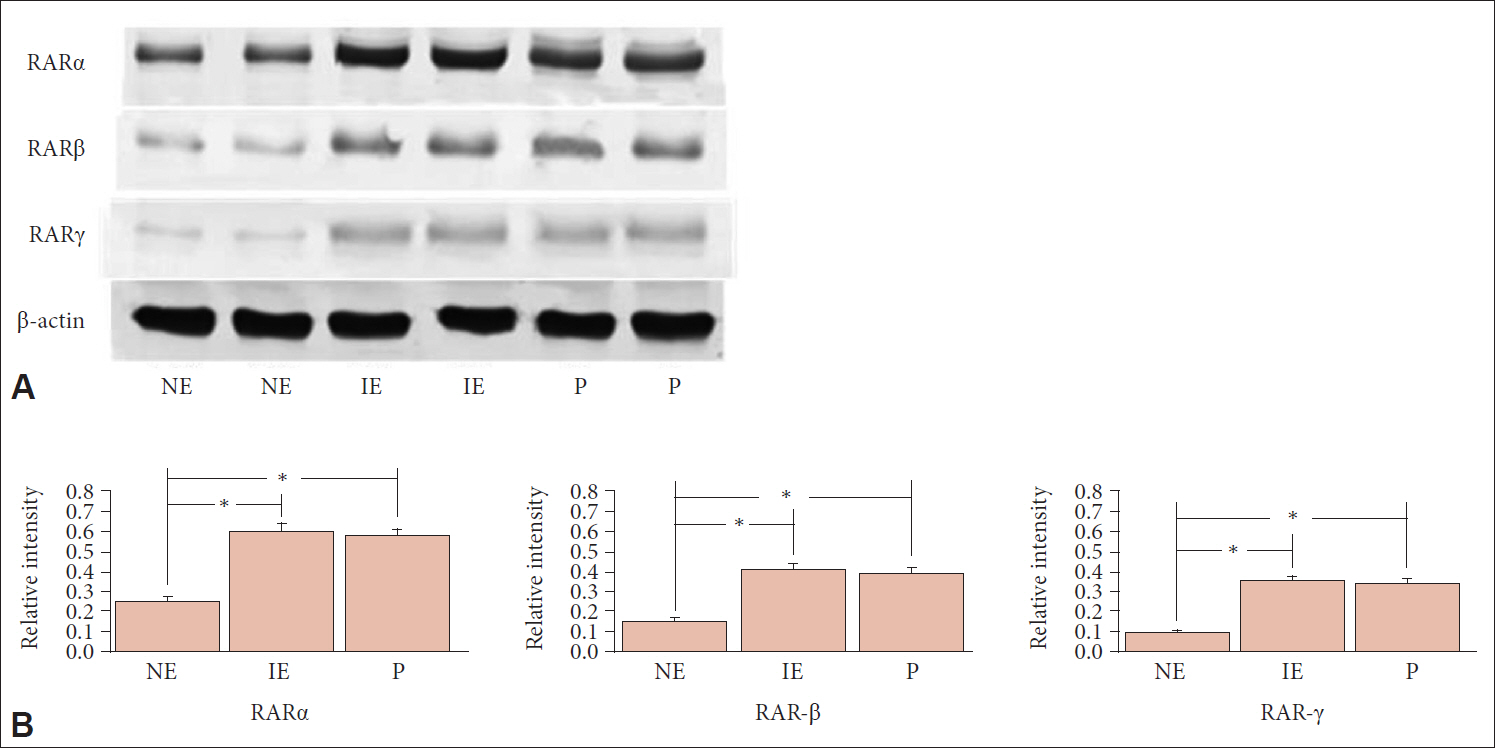J Rhinol.
2022 Mar;29(1):26-31. 10.18787/jr.2021.00389.
Expression and Distribution Pattern of Retinoic Acid Receptors in the Nasal Mucosa
- Affiliations
-
- 1Department of Otorhinolaryngology-Head & Neck Surgery, College of Medicine, Korea University, Seoul, Republic of Korea
- KMID: 2528316
- DOI: http://doi.org/10.18787/jr.2021.00389
Abstract
- Background and Objectives
Retinoids are naturally occurring vitamin A derivatives that regulate cellular processes and metabolism. In particular, retinoids play a key role in cellular proliferation by binding to retinoic acid receptors (RAR)-alpha, beta, and gamma. Considering the functional role of nasal mucosa where active cell regeneration occurs, RAR may play a role in tissue remodeling of the human nasal mucosa.
Methods
In this study, we investigated the expression and distribution pattern of RAR using reverse transcription-polymerase chain reaction (RT-PCR), immunohistochemistry (IHC) and Western blot in normal ethmoid mucosa (NE), chronic rhinosinusitis (IE) and polyp (P).
Results
IE and P samples showed higher expression levels of RAR in RT-PCR and Western blot than NE samples. RAR reactivity was also observed in the NE group, which indicates that cell regeneration also occurs in normal condition. Through IHC, we found the localization of RAR. RAR-α was distributed in the epithelial cells, submucosal glands, and endothelial cells. RAR-β was located in the basal epithelium, while RAR-γ was present in goblet cells and submucosal glands. The staining intensity of RAR-α, β and γ was higher than that in the NE group. Especially in the P group, RARs were abundantly distributed in the stalks of polyps.
Conclusion
The stalk region contains a lot of collagen and fibroblasts to support polyp formation, and the greater amount of RAR in the stalk suggested that RARs may be associated with angiogenesis and cell proliferation. Accordingly, elevated RAR levels in chronic rhinosinusitis could indicate that RARs play a critical role in cell regeneration, angiogenesis and immunomodulation under inflammatory conditions in the human nasal mucosa.
Keyword
Figure
Reference
-
1. Cassani B, Villablanca EJ, De Calisto J, Wang S, Mora JR. Vitamin A and immune regulation: role of retinoic acid in gut-associated dendritic cell education, immune protection and tolerance. Mol Aspects Med. 2012; 33(1):63–76.
Article2. Ziouzenkova O, Plutzky J. Retinoid metabolism and nuclear receptor responses: new insights into coordinated regulation of the PPAR-RXR complex. FEBS Lett. 2008; 582(1):32–8.
Article3. Saito A, Sugawara A, Uruno A, Kudo M, Kagechika H, Sato Y, et al. Alltrans retinoic acid induces in vitro angiogenesis via retinoic acid receptor: possible involvement of paracrine effects of endogenous vascular endothelial growth factor signaling. Endocrinology. 2007; 148(3):1412–23.
Article4. Rogers DF, Barnes PJ. Treatment of airway mucus hypersecretion. Ann Med. 2006; 38(2):116–25.
Article5. Duong V, Rochette-Egly C. The molecular physiology of nuclear retinoic acid receptors. From health to disease. Biochim Biophys Acta. 2011; 1812(8):1023–31.
Article6. Schön M, Rheinwald JG. A limited role for retinoic acid and retinoic acid receptors RAR alpha and RAR beta in regulating keratin 19 expression and keratinization in oral and epidermal keratinocytes. J Invest Dermatol. 1996; 107(3):428–38.7. Campbell MJ, Park S, Uskokovic MR, Dawson MI, Koeffler HP. Expression of retinoic acid receptor-beta sensitizes prostate cancer cells to growth inhibition mediated by combinations of retinoids and a 19-nor hexafluoride vitamin D3 analog. Endocrinology. 1998; 139(4):1972–80.8. Scherzad A, Hagen R, Hackenberg S. Current understanding of nasal epithelial cell mis-differentiation. J Inflamm Res. 2019; 12:309–17.9. Watelet JB, Van Zele T, Gjomarkaj M, Canonica GW, Dahlen SE, Fokkens W, et al. Tissue remodelling in upper airways: where is the link with lower airway remodelling? Allergy. 2006; 61(11):1249–58.
Article10. Radajewski K, Wierzchowska M, Grzanka D, Antosik P, Zdrenka M, Burduk P. Tissue remodelling in chronic rhinosinusitis - review of literature. Otolaryngol Pol. 2019; 73(5):1–4.11. Fukazawa K, Ogasawara H, Umemoto M, Sasaki R, Sakagami M. Regeneration of epithelial cells of the maxillary sinus mucosa in chronic sinusitis. Med Electron Microsc. 1998; 31(1):10–5.
Article12. Maccabee MS, Trune DR, Hwang PH. Paranasal sinus mucosal regeneration: the effect of topical retinoic acid. Am J Rhinol. 2003; 17(3):133–7.
Article13. Kim CH. Chapter four - Retinoic acid, immunity, and inflammation. In : Litwack G, editor. Vitamins and the immune system. 1st ed. Academic Press;2011. p. 83–101.14. Chen MC, Hsu SL, Lin H, Yang TY. Retinoic acid and cancer treatment. Biomedicine (Taipei). 2014; 4(4):22.
Article15. A Z, Cd K, Ad V, T K, Li S. Expression of retinoic acid receptor (RAR) α protein in the synovial membrane from patients with osteoarthritis and rheumatoid arthritis. Int J Biomed Sci. 2007; 3(1):46–9.16. Hirshoren N, Neuman T, Gross M, Eliashar R. Angiogenesis in chronic rhinosinusitis with nasal polyps and in antrochoanal polyps. Inflamm Res. 2011; 60(4):321–7.
Article17. Karatzanis AD, Samara KD, Antoniou KM, Lymbouridou R, Chatzakis N, Spandidos DA, et al. Investigation of angiogenetic pathways in nasal polyposis. Mol Med Rep. 2012; 5(5):1158–62.18. Nemati S, Keihanian F, Saeidinia A, Bakhshaei M. Effect of bevacizumab on growth of human nasal polyposis in vitro; an off-label use of anti-angiogenic agent for nasal polyposis treatment. Drug Des Devel Ther. 2019; 13:3383–9.19. Wang M, Sun Y, Li C, Qu J, Zhou B. Eosinophils correlate with epithelial-mesenchymal transition in chronic rhinosinusitis with nasal polyps. ORL J Otorhinolaryngol Relat Spec. 2022; 84(1):70–80.
Article
- Full Text Links
- Actions
-
Cited
- CITED
-
- Close
- Share
- Similar articles
-
- Regulation of Sodium-iodine Symporter Expression by Retinoic Acid in Thyroid Cancer Cell Lines
- Developmental mRNA Expression of Cellular Retinoic Acid Binding Protein l and l in Rat
- Anticancer Effect and Apoptosis of All-trans-retinoic Acid on the Human Ovarian Epithelial Carcinoma Cell Lines
- Upregulation of Prostasin in Nasal Polyps
- Effect of Retinoic Acid on the Expression of PDGF Receptors During Palatogenesis




